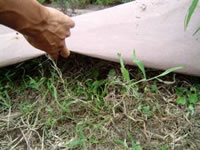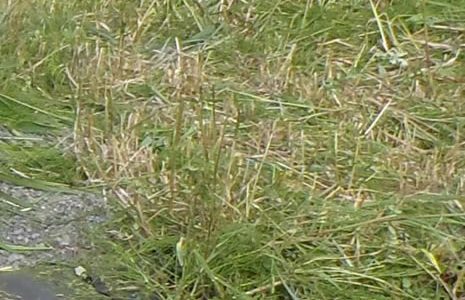What is a weed control fabric?
The weed control sheet can reduce the need for weeding for a long time.

Weeding puts a strain on the lower back, and herbicides affect human health and the soil in no small way. Also, both weeding and herbicide application need to be done regularly.
Laying straw mats or steel plates on areas with weeds can control weed growth. Yet, straw mats deteriorate quickly, and steel plates are heavy and difficult to install. Weed control fabrics are much easier to install and last longer and thus can drastically reduce the workload.
Five points to check when selecting a weed control fabric

Many manufacturers are selling various weed control fabrics for different price ranges and specifications. Please check the following points to select the proper weed control fabric among the many available.
- Shading performance
- Penetration resistance
- Water permeability
- Durability
- Ease of installation
Block sunlight, the source of life for weeds

Shading performance is an important aspect of a weed control fabric.
Plants grow through photosynthesis.
Weed growth can be prevented by blocking sunlight.
Shading performance is the value indicating the ability to block sunlight.
Penetration resistance to prevent penetration through the fabric
Plants can conduct photosynthesis above a fabric even when it blocks sunlight and prevents photosynthesis if the plants penetrate through the fabric.
Plants with underground stems, such as field horsetails and Congo grass, can germinate beneath the fabric if they are conducting photosynthesis in other uncovered areas. In addition, some of the gramineous plants have sharp tips in their buds that can easily penetrate through week fabrics with their penetration force. In particular, the sharp buds of field horsetails and Congo grass have strong penetration force and thus attention is required. Penetration resistance is the strength to resist a penetration force. Weed control fabrics are required to have high penetration resistance.

The fabric must be able to let water pass through it.

If the fabric has no permeability, puddles are created on the fabric during rain. The puddles will eventually turn into muddy puddles. Then, the seeds of weeds fly into the muddy puddles and germinate. It is meaningless if weeds start to germinate on the fabric, although the fabric is controlling weeds beneath it with shading performance and penetration resistance.
If the fabric is installed on an inclined plane, and the permeability is low, the rainwater that is usually absorbed into the ground will flow down on the fabric and discharge into unintended areas. Secondary damage, such as problems with neighbors caused by the discharge, must be avoided.
Judo experts have the strength that controls the force of an opponent and the flexibility to dodge the force of the opponent. This applies to weed control fabrics as well. Weed control fabrics are expected to have both the strength to control weeds and the flexibility to let water flow through them.
It is meaningless unless weed control fabrics can control weeds for a long time.
Durability thus becomes important when selecting a weed control fabric. It is necessary to select a weed control fabric by determining whether the fabric has enough durability that matches the cost.
Heavy fabrics are difficult to install.
Weed control fabrics come in various appearances and weights depending on production methods. Heavy fabrics mean difficulty in handling and poor installation efficiency. The poor installation efficiency caused by weight becomes especially obvious when installing the fabric on slopes. Ease of installation means being lightweight and is an important aspect of weed control fabrics.
Characteristics of weed control fabric and its performance
Now, take a look at the characteristics and performances of different types of weed control fabrics based on the above five aspects to check.
Weed control sheet made of woven fabric

Weed control sheet made of woven fabric looks like a black tarp created by weaving belt-like films. This is a low-cost type frequently sold by hardware stores. It is characterized by low price and low strength.

Reasons for the low strength are that since films are only woven in the vertical and horizontal directions without bonding, the fabric is vulnerable to diagonal pulling forces, and tends to create gaps among films, causing weeds to penetrate through them. In addition, the edges of such fabrics easily come loose, and loose ends fly away and cause problems with the neighbors in some cases. Permeability is also slow, and water draining plans must be created.

*Weeds penetrating through woven weed control fabric |
Installing a weed control fabric becomes meaningless if weeds grow through it.
Needle punch type

After entangling the fine fibers, they are thermal-bonded by punching through them with heated needles. This very thick fabric looks like felt. This fabric has many sections without thermal bonding. Thus, many needle punch-type fabrics have unwoven fabric attached to one side. Since two types of fabrics are pasted onto each other, the cost is higher. The fabric is also heavy, which means difficult installation.

Furthermore, needle-punched sections peel off, and birds rip them away and take them for nest building. Permeability is also low, and clogging occurs frequently.

Photograph taken two years after installation
Peeling in needle-punch sections and removed tapes are found.
Spunbond nonwoven fabric

Individual fibers are thermally bonded. Since the fabric is fused based on the overlapping of all fibers, it has high tensile strength and high penetration resistance. In addition, the surface is smooth and clogging is unlikely to occur. This type of fabric can be installed on slopes. Since the fabric blocks sunlight well, it can prevent photosynthesis of weeds.
Reasons for the popularity of Xavan®

Xavan® weed control fabric is being used at various scenes, such as public enterprises and solar power plants. In addition to various advantages of spun-bonded nonwoven fabric in terms of the ease of installation, thick fibers are structured in extremely thin four layers. The spun-bonded nonwoven fabric performs excellently as a weed control fabric in other aspects as well.
Weed control fabrics are usually installed in harsh environments.

They are used outdoors. They are thus kept exposed to wind and rain. They need to withstand harsh environments.
*The spun-bonded nonwoven fabric is highly permeable.
Polypropylene and polyester
Xavan® weed control fabric is made of polypropylene.
Why is it made of polypropylene?
Here is the comparison between polyester, the fiber that is commonly used, and polypropylene.

One of the characteristics of polypropylene is that it is resistant to acids and alkalis.
In addition, no hydrolysis occurs with polypropylene.
Hydrolysis
Hydrolysis is the process that a material deteriorates when it is kept being exposed to water. Hydrolysis occurs to polyester.

*Even the thick sole of a sneaker will deteriorate like this through hydrolysis.
Yet, hydrolysis does not occur to polypropylene. In particular, the polypropylene used in Xavan® 240 Green has remarkable weather resistance compared to ordinary polypropylene.
Xavan® weed control fabric is a well-balanced fabric in all aspects.
Xavan® weed control fabric is a well-balanced fabric with high shading performance, high penetration resistance, and high permeability. It can be used for various purposes from weed control in gardens to weed control in solar power plants.

*Xavan® weed control fabric made of extra-thick fibers has a remarkable tensile strength.



